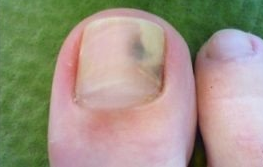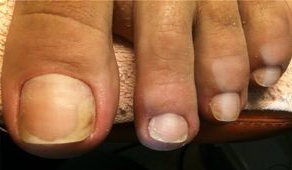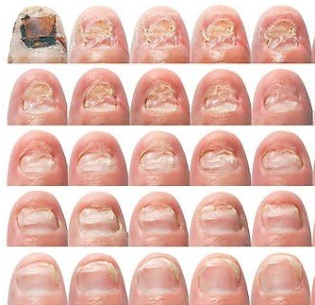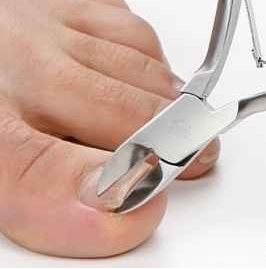Nearly one out of every three humans occurs fungus in the nails of the feet. The disease bears the name of the onychomycosis, and causes the exfoliation and crumbling of the surface of the nail. Onychomycosis may occur at any age and require timely literacy of treatment under the supervision of a specialist.

What is onychomycosis?
Onychomycosis - fungal and the defeat of the the surface of the nail. The disease can be caused by a fungus-the dermatophytes, or with microsporia. The fungi have a negative impact on the base of the nail – keratin and, little by little eating, cause the deformation changes.
There are the following types of onychomycosis:
- Normotroficheskie. The change of color of the nails, the appearance of stripes and spots.
- Hypertrophic. Not only there is a change of color, but and slight deformation. More often, the nail becomes deformed with the edges.
- Onicholocheskiy. The nail is destroyed, atrophy and excluded.
Fungicide defeat can cause deformation of the nail at the free edge of the sides and on the rear panel of the roller. As the development of the disease that affects the process of the entire nail plate.
The causes of the
The fungus in the nails of the feet appears not only by the reduction of immunity. Approximately 70% of the people are infected from a sick person, and often is familiar to them. Small flakes of skin with a stop order they fall in items for the home and, when it comes into contact with the healthy tissue of the nail or skin, to infect a healthy person.
Most often, the infection occurs through:
- The sponge.
- The sponge.
- Towels.
- Mats.
- The footwear.
- Manicure toilet.

When you visit the beach, the sauna and bathrooms without running shoes, there is a high risk of infection by the fungus of the feet. The humidity and temperature of the infection occurs with more frequency.
Special care should be in public places, where people go barefoot. Fungi resistant to low and high temperatures, and on the beach in the sand, keep their viability for several months.
The wound and the abrasion in the leg in case of contact with infected articles may be the cause of the onychomycosis. It is not worth to wear the shoes of other people, even if the external manifestations of fungi in them has not been detected. They can be carriers of pathogens of the intestinal flora, and with a strong immunity from the disease does not manifest itself.
The signs of
The initial phase of the fungus in the feet is manifested in the dryness and flaking. At that time the person may not notice visual changes nail plates, but having itching and burning in the area of the fingers. Gradually increases the sweating and, in some cases, bubbles are produced and calluses appear. As the adoption of a nail fungus, it begins to change color, become brittle and cracked.
The nail of one finger under the microscope contains the mixture and the emptiness. The legs begin unpleasant odor, and the total of the symptoms intensifies.
In severe cases, the increase of the body temperature occurs, expressed pain syndrome, which does not scroll correctly. As you see fungus in the nails of the feet, and what changes are characteristic of him largely depends on its type and strength of the immunity of the person.
The fungus exerts the action antifungal is manifested as yellow longitudinal bars of yeast - called scales on the surface of the nail and its yellowish color. The fungus is the cause of the surface of the defeat of the surface of the nail, which can be yellow, brown, blue, or green.
Description of the disease in the case of the different types of fungi is different, but it has general symptoms.
These include:
- The color change of nail plates.
- Itching and burning in the skin of the toes.
- The stripes and spots under the nails.
- The crumbling and destruction of the nail from the sides.
- The redness of the skin around the nails.
- Hyperkeratosis (thickening of the nail).
Begins with a disease of the defeat of the nail little finger or the thumb on the feet, after which occurs the infection in all the plates. Occurs keratinization of the nail, it condenses and crumbles. Mycoses often affect the adult people and the elderly, and in children are observed very rarely.

The treatment takes care of medical dermatologist or mycologist. For an accurate diagnosis of the visual inspection is not enough, and requires the completion of laboratory studies. To do this, a small part of the nail, it is sent to the research microscpica. When it detects a fungus set its appearance by planting in broth culture.
Despite the fact that the majority of diseases nails plates of the adults, it is a fungus, there are a number of pathologies with similar sintomatologa. The defeat of nail fungus can cause similar features, but requires a different treatment. It is a whitlow, or acute purulent inflammation of the fingers, requires surgical treatment.
That cure nail fungus?
Not worth the wait, the fungus will be done independently. The more time a person is suffering from this disease, the more difficult it will be for the further processing.
The duration of treatment and the selection of medications depends on:
- The stage of the disease.
- The degree of damage in the nail.
- Clinical forms of the disease.
The initial stages of fungal nails and feet require the local application of drugs which may be in the form of:
- Of the solutions.
- A fungal cream.
- Creams.
- Varnishes.
Apply to medicines for external use, preferably after keratolytic treatment of the surface of the nail.
Before each procedure for the application of medicines should be:
- Do mylno-soda tray. In a small tray and add a tablespoon of baking soda and the salt and 50 g of laundry soap. Keep the soles of your feet in a solution of approximately 15 minutes.
- Treat the nail damaged. Through a special lime to the top layer of the nail will weaken, so that the medicine is better absorbed.
- Apply the medication. The drug put on clean dry nails of the feet and the skin around them.
When you use the solutions, ointments and creams medicine put 2 to 3 times a day, lucky – 2 times a week. The course of treatment installed by the doctor in terms of the damage.
If nail plate totally surprised and local medicines do not have positive effects, recommended to combine with antifungal agents.
Systemic medications have a long list of contraindications and should be the primary care physician. The majority of them it is prohibited to take during pregnancy and lactation, in children and in chronic diseases of the liver and kidneys.

In severe cases of under-fungal may be necessary to remove the surface of the nail. The procedure can be performed both through the surgery, and with the help of keratolytic containing salicylic acid and urea.
The removal of the affected nail keratolytic patch is distinguished by its ease of use. After rasparivaniya feet the patch with care put on the plate of the affected nail and seal the tape. After a few days the patch is removed, cut the affected area of the plaque, are one of the antifungal drugs. The procedure is performed several times.
During the treatment it is important to eliminate the risk of return to self-infection. To do this, all the footwear deal with a disinfectant solution. Of the socks, which they put before the start of treatment, it is best to get rid of it. Hereinafter, each month pass to reprocess the shoes and the clothes. If you waive this procedure, through a short period of time, the fungus may appear again.
The symptoms and treatment of fungi, totally individual, and at the first symptoms of this disease, you should consult your doctor. Only he is able to make an accurate diagnosis and to pick up effective medication. Otherwise, the fungus will begin to spread to other nails and will destroy them.





























